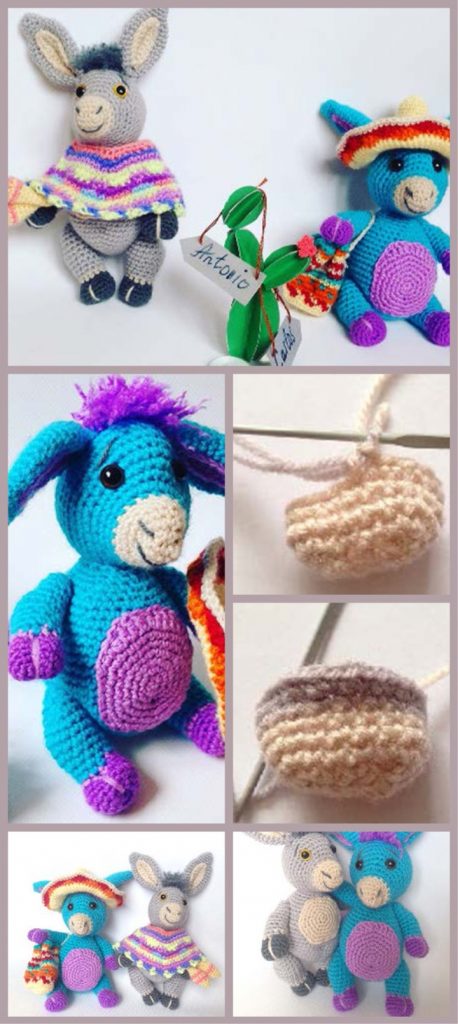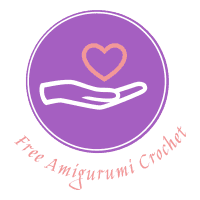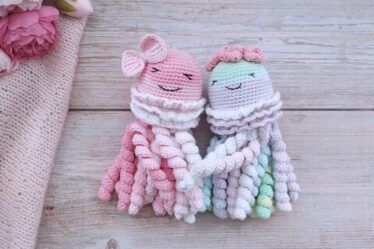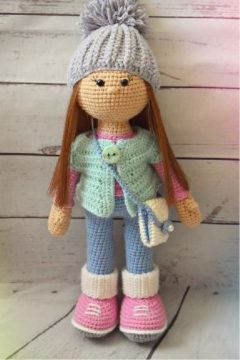Hello dear Amigurumi Followers
Today we share Amigurumi Donkeys Free Pattern for you. As you know we share new free amigurumi pattern every day. The main crochets are gazelle, amigurumi bear, pola, crochet panda, penguin, giraffe, llama, pig, bunny, clown, lamb, bee, crochet unicorn, amigurumi doll, fox, penguin, dinosaur, crochet elephant, hippo, monkey, crochet cat, crochet dog and more …
Todays daily new amigurumi free crochet pattern is Amigurumi Donkeys.
I want to give you some informations about this amigurumi free pattern ; Donkeys.

For work you will need:
yarns Children’s Novelty, Pechora –
gray, beige, dark gray for
donkey, any color of the same thickness
for accessories
– crochet hook number 2;
– eyes
– a gypsy needle
– scissors;
– filler
You can use any yarn suitable color, thickness is not is fundamental. Of fine yarn
A toy of a smaller size will more thick – more.
Hook and spokes should be selected, starting from thickness of the selected yarn.
Crochet: circular, spiral
KA-ring amirugurumi
VP-air loop
RPS-column without crochet
SSN-column with one crochet
PSSN-half-cousin with crochet
UB-reduction (2 loops tie together)
PR-increase (2 loops to be out of
one loop of the previous row)
Amigurumi Donkeys Free Pattern
HEAD
We knit beige (head of nose)
1. 5 VP
2. In the second loop from the hook we bind 3 scs, then 1 sc in 2
The following loops, in the last loop 3 RLS, further along the chain of 1 sc in 2 the following loops (10)
3. In 1 loop of the PR, then 1 RLS, PR, the next 2 loops of 1 sc, 1, 2, OL, 1 RLS per trace 2 loops. (14)
4. 1 RLS, RR, 1СБН, ПР, 4 СБН, ПР, 1 SCN, PR, 3 RLS (18)
5-6. 18 RLS (end of row and color change is obtained approximately in middle spout)


7. Change the thread to the main, gray (color of the trunk) 18 RLS
8. 6 RLS, 6 RR, 6 RLS (24) (loops The increase is The side of the spout opposite where the seam is a change of color (he is on his chin)



9. 24 RLS
10. (3 SCR, OL) * 6 (30)
11. (4 SCR, PR) * 6 (36)
12. (5 SCR, OL) * 6 (42)
13- 18. (42) – 6 rows
19. (5 СБН, УБ) * 6 (36)
Decreases are made for front half loop (see photo), canvas it turns out that the level is not visible.
Filling the head with filler
20. (4 СБН, УБ) * 6 (30)
21. (3 RTS, UB) * 6 (24)
22. (2 SC, UB) * 6 (18)
Adding filler Nuance! If your eyes are regular sewing, further we subtract and close the hole in the head. If screw (like me), do otherwise. We correct the snout of the donkey tighteners, only after them we attach screw eyes, so far hole do not close. We make a tightener for the peephole (see photo). The thread is the same color as the head We insert the needle approximately between 11 and 12 rows (closer to the nose), between with the eyes of 8-9 hinges, we draw a little higher on the sides and wider by 1 loop (for symmetry of the muzzle). .Tak 2-3 times, the thread is fixed. The ends can be tied and hide inside the head. We insert the eyes, check the symmetry, get a little from the top of the filler’s head, to fix the eyes, to fill the head.
23. (1СБН, УБ) * 6 (12)
24. 6 UB (6)
. Use the needle of the loop to tighten and sew We will do the tightening on the spout after fixing the ears


Ears
The main part, we knit gray.
1. SC, (6) RLS
2. (1 SC, PR) * 3 (9)
3- 4. (9) 5. (2 SC, OL) * 3 (12)
6. (1 SC, OL) * 6 (18)
7. (18) 8. (5 SCR, OL) * 3 (21) 9 -16. (21) 17. (5 СБН, УБ) * 3 (18) 18. (1 СБН, УБ) * 6 (12)

To ears bent in different directions, at this stage, you need to insert the frame- wire. The length of the ear is 6 cm, so for each you need a wire 16 cm long, (ends of 1.5 cm will be inside the head) We fold the bottom of the ear, connect-bind the edge for both sides connect. loops. We leave a long string for sewing The second ear is knitted similarly.

INSIDE THE EAR
knit with beige thread (like nose)
1. 11 VP, from the second loop from the hook knit 3 connect hinges, 7 RLS.
2. Do PP, turn knitting, we knit 6 RLS (lifting loop replaces first loop), 3 will connect the loops further 1 VP, knit on the second side mirror 3 connect loops, 7 sc.
3. PP, turn knitting, 5 sc, 4 connect the loops, the fifth to the top details, 4 hinges, 6 RLS We leave the thread for sewing. Apply this part to the main ear, we sew (we do not introduce the needle Through, and sew over the top wall of the main ear, everything will be look exactly and neat)

CULTIVATION
1. SC, 6 sc
2. 6 PR (12)
3. (1 SC, PR) * 6 (18)
4. (2 SC, OL) * 6 (24)
5. (3 SCR, PR) * 6 (30)
6. (4 sc, ap) * 6 (36)
7. (5 SCR, PR) * 6 (42)
8. (6 SCN, OL) * 6 (48)
9.- 16. (8 rows) (48)
17. (6 СБН, УБ) * 6 (42)
18. (42)
19. 6 RLS, (3 RLS, UB) * 6, 6 RLS (36) (in this set of 6 deductions, after 3 can put a marker, this will be the middle pusik, when assembling a convenient landmark to observe symmetry)
20. (36)
21. (4 SCN, UB) * 6 (30)
22. (3 SCN, UB) * 6 (24)
23. (2 SC, UB) * 6 (18)
24. (4 SCN, UB) * 3 (15)
Leave a thread of 20 cm for sewing the head Fill the body with filler

TUM (like the gray donkey in the photo) 1 OPTION
1. SC, 6 sc
2. 6 PR (12)
3. (1 SC, PR) * 6 (18)
4. (2 SC, OL) * 6 (24)
5. (3 SCR, PR) * 6 (30)
6. (4 sc, ap) * 6 (36) 2
OPTION (like a blue donkey) – on a photo
1. SC, 6 sc
2. 6 PR (12)
3. (1 SC, PR) * 6 (18)
4. (2 SC, OL) * 6 (24)
5. (3 SCR, PR) * 6 (30)
6. (4 sc, ap) * 6 (36)
7. Make a more elongated, oval shape. 6 СБН, 3СБН in one loop, 8 СБН, 3 in 1 loop, 7 SCN, 1 SSN, 2 PRSP, 2 SSN, 1 PRSP, 2 SSN, 2 PRSP, 1 SSN, 1 SSN Leave the sewing thread 20 cm

LEGS
We knit in dark gray color
1 . SC, 6 sc
2. 6 PR (12 sc)
3. (3 SCR, OL) * 3 (15)
4. (4 SCR, OL) * 3 (18)
5. (18)
6. (4 СБН, УБ) * 3 (15)
7. (3 RTS, UB) * 3 (12)
8. (12 СБН) beige color
The ends of the threads are fixed inside We knit the main color
9-10. (12 sc)
11. (3 SCR, OL) * 3 (15)
12. (15 sc)
13. (4 SC, OL) * 3 (18)
14.-16. (18 sc)
We fill the leg
17. (4 SCN, UB) * 3 (15)
18. (3 RTS, UB) * 3 (12)
19. 6 UB Remove the remaining hinges and sew them with a needle.
We leave the thread for sewing 30 cm (we will sew both legs)
The second leg is knitted similarly, the edge of the gray thread at the end of the knitting is fixed and we hide inside of a leg

Hand writing. In the 12-13th series we formed an ulnar bend, take the handle, inside of the elbow to yourself , in the middle from below, we introduce a needle between beige and dark gray series, as if wrapping along the handle, above also between these rows, a little tighten, straighten the thread so she went smooth. Then again, enter the bottom in the same place and we deduce above, in the likeness as we did on We insert the needle either to the left or To the right and to the bottom. linen-as will be more accurate). On the picture worked a little higher on the floor of the loop. At the bottom we tie the thread and hide it inside

TAIL
We knit with a gray thread We retreat to the threads of 20 cm, we make a spacecraft (this thread we sew the tail)
1. SC, 6 sc
2. (2 SC, OL) * 2 (8)
3.-5. (8 sc)
6. (2 СБН, УБ) * 6 (6)
7.-8. (6CBN)
We fix the thread, so we leave everything, for The remaining loops will be fastened with a brush tail Collecting the head The bottom of the ears is folded in half, sewed, fixed to the head with needles, between ears 3 cm, the hat sits perfectly. Ears are fastened approximately between 15-17 rows. We form the spout with the thread of the spout color. We introduce the angle θ into the first loop of the first series nose (it can be seen in the canvas, the left corner of the nose) – we show in the same row in the right extreme loop. We enter at an angle of 45 degrees between 4 and 5 rows (slightly tighten thread), we draw the needle symmetrically in the opposite left side, and enter in the first loop (whence started the contraction). Then we draw the needle at the same angle below – between 4 and 5 rows, approximately 3 loops lower from the upper corner of the nose and insert the needle symmetrically to the right, directing the needle into the very first loop. Nostrils and the mouth is formed. So repeat again, pulling the thread. . However, not so It is important to observe exactly this order, the main principle is to understand and form the nostrils and mouth. Then we go through a black or a dark thread the same image on the ready-made features of the muzzle and, if desired, make the eyebrows

We sew our hands, we make a thread, (you can be buttoned). Prikalyvayu both hands to the trunk to fix them, I sew this way- we stick the needle from the outside of one hand through the trunk and bring it out The needle is on the outside of the second arm, retreating 3 loops to the side (along the row) we stick the needle and pass through the trunk back outside the second hand


To the limbs remained mobile, On the outside of the hand is a small stitch, and from the inside of the hand we hold needle all the time through one hole. A thread we fix from the inside of the hand, so that it was not seen. Legs sewn similar way. Sew a tail when it is sewn, the last stitch is done through the trunk and remove the needle in the lower abdomen, In the middle, through one loop we introduce a needle again in a pussy and put out through the trunk to the tail, we just tighten the thread, fix it, the navel is obtained.

HAIRSTYLE
We wrap the thread around 2 fingers, from the bottom cut the entire beam, it’s a set for tail brushes and hair. We fix the threads as shown in the photo, the area on the head determine how you like. In this donkey it is from ear to ear, in width – 3 rows, if the “shock” was a little long, you can cut it. On ponytail fasten on the edge

MARACAS
1. SC, 6 sc
2. -6. 6 RLS
7. (1 SC, PR) * 3 (9)
8.-9. 9 RLS
10. (2 SC, OL) * 3 (12)
11. 12 RLS of colored thread
12. 12 RLS
13. (2 СБН, УБ) * 3 (9) we fill filler
14. (1 СБН, УБ) * 3 (6) close hole BUCKET 1


BUCKET
1.KA, 6 sc
2. 6 PR (12)
3. (1 SC, PR) * 6 (18)
4. (2 SC, OL) * 6 (24)
5. (3 SCR, OL) * 6 (32)
6. We knit the back half loop for 32 RLS
7.-19 (32 sc)
20. (3 sc, vp) so until the end of the series, under VP skip one loop of the base, Repeat 4 loops. Obtained through every 3 hole loops in which we let’s pass the lace.
21.-22. (32 sc) In a bag to pass or a ready lace, or bind 30 VP and after passing through connect the chain. Choose colors for accessories any, drawing too.

PONCHO (hook can take 2.5 or 2 slightly free to knit)
1. 32 VP
2. 32 VP
3. 7 sc, 3 sc in one loop) * 4 (40)
4. 40 RLS
5. 8 sc, 3 sc in 1 loop, (9 sc, 3 SBN in 1 loop) * 3, 1 sc (48 sc)
6. 48 RLS
7. 9 sc, 3 sc in 1 loop, (11 sc, 3 RLS in 1 loop) * 3, 2 sc (56)
8. 56 RLS
9. 10 sc, 3 sc in 1 loop, (13 sc, 3 RLS in 1 loop) * 3, 3 RLS (64)
10. 64 RLS
11. 11 sc, 3 sc in 1 loop, (15 sc, 3 sc in 1 loop) * 3, 4 sc (72)
12. 72 RLS (in each 4 picos-3 loop RLS blue, 1 RLS light green + pico,)

SOMBRERO
1. SC, 6 sc
2. (1 SC, PR) * 3 (9)
3. (2 SC, OL) * 3 (12)
4. (3 SCR, OL) * 3 (15)
5. (4 SCR, OL) * 3 (18)
6. 18 RLS
7. (5 SCR, OL) * 3 (21)
8. 21 RLS
9. (6 SCR, OL) * 3 (24)
10. 24 RLS
11. 24 RVS
12. (3 SCR, PR) * 6 (30)
13. 2 RLS, RR, 2 RLS, 7 VP (at the bottom we pass 7 loops of the base, we inject hook in 8 loop), 2 RLS, RR, 2 RLS, RR, 2 RLS, 7 VP (at the bottom we pass 7 loops bases, we stick a hook in 8 loop), 2 RLS, PR (34)
14. (16 SCR, OL) * 2 (36)
15. (5 SCR, OL) * 6 (42)
16. (6 SCR, OL) * 6 (48)
17. (7 SCR, OL) * 6 (54)
18. (8 SCN, OL) * 6 (60)
19. (9 SCR, OL) * 6 (66)
20. (10 SCR, OL) * 6 (72)
We turn the hat and knit from the wrong side (see photo). When we do Lapel, to the outside turned out the front side Change color
21. (RLS, PRSP, 3SSN, PRSP, SSN, SS) * 9 (72) Change color
22. (PRSP, SSN, 3SS, RLS, PRSP, CLO) * 9 (72) Change color
23. 72 RLS. That’s all ! To all obedient loops and beautiful toys !!!




